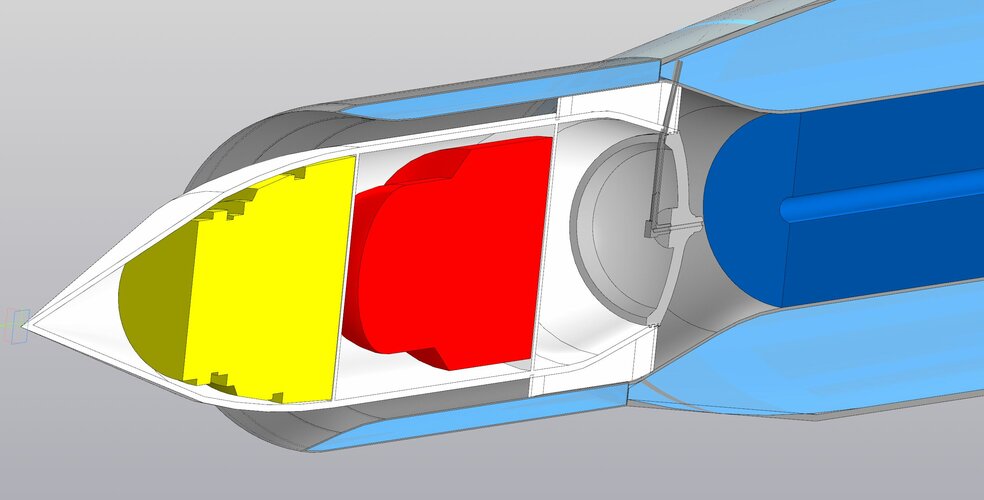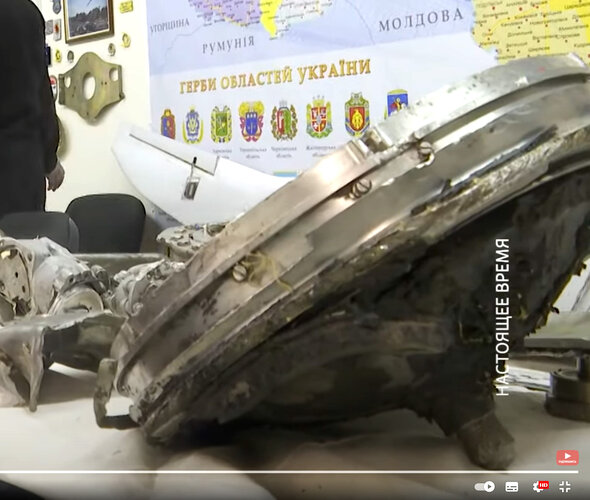D
You are using an out of date browser. It may not display this or other websites correctly.
You should upgrade or use an alternative browser.
You should upgrade or use an alternative browser.
Russian 3M22 Tsirkon Hypersonic Missile
- Thread starter bobbymike
- Start date
Scott Kenny
ACCESS: Above Top Secret
- Joined
- 15 May 2023
- Messages
- 6,016
- Reaction score
- 4,887
It's not like they're invisible on radar. They fly high, so easy to detect.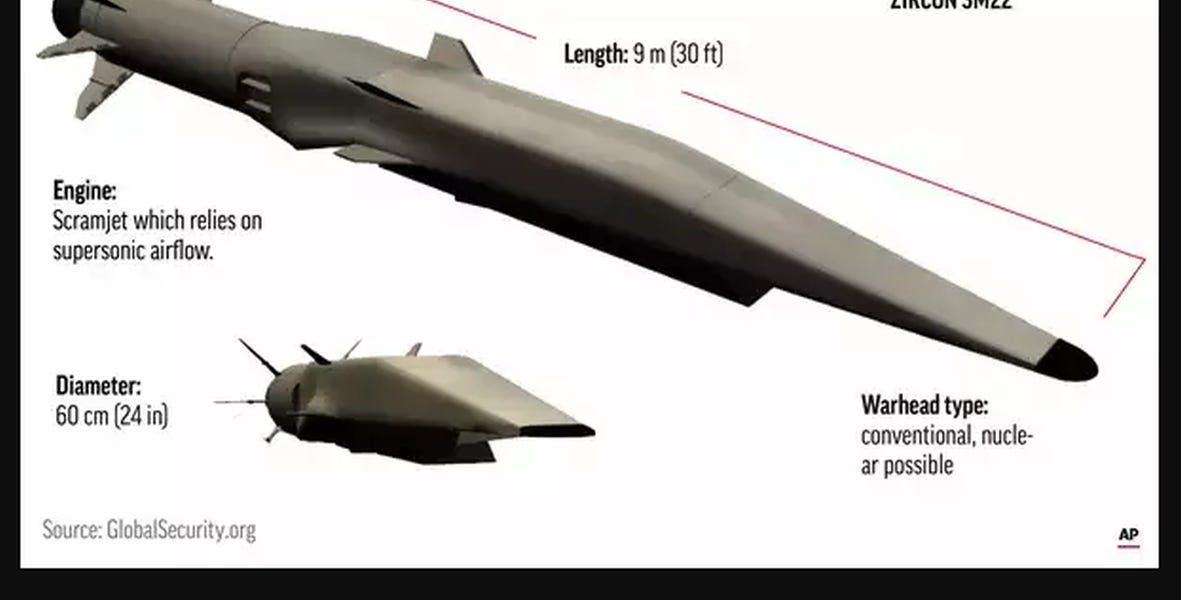
Ukraine War, 26 March 2024
Hello everybody! That was an… ‘interesting’…. day yesterday, as several important things have happened and yet, many of them appear to have ‘passed unobserved’, while others seem to be based on outright refusals to accept realities of this war. What am I talking about this time?xxtomcooperxx.substack.com
Tom Cooper point of view: while the Ukrainians may have shot down two Zircons, this is not exactly good news for a host of reasons. The missiles came like bats outta hell; with absolutely zero warning.
Just two sonic booms in terminal descent and then KABOOM.
Kiyv was spared only because other places were hit by a volley of Zircons and warned the capital: which had barely enough time to point and launch Patriots.
So this was a "lucky" shot - as far as "warning" was concerned.
You do need your long-range search radars on the ball, though, to pass the message to the SAM batteries to go live for fast-movers.
Dilandu
I'm dissatisfied, which means, I exist.
What do you expect? There are many "experts" still thinking that all modern tech of China and Russia is "stolen from America".Level of expertise of people still illustrating their Zircon writings with X-51A alike stuff in 2024 is frustrating
Dilandu
I'm dissatisfied, which means, I exist.
They aren't invisible, but they fly very fast and follow aerodynamic, not ballistic trajectory. Which means that they are harder to detect than ballistics (the trajectory is lower) and they cross the radar range very fast, leaving operators little time to react.It's not like they're invisible on radar. They fly high, so easy to detect.
Scott Kenny
ACCESS: Above Top Secret
- Joined
- 15 May 2023
- Messages
- 6,016
- Reaction score
- 4,887
Right, but they're still 70+kft/25+km in altitude, not down in the weeds at 5m AGL. Blackbird height. Blatantly obvious that something's there.They aren't invisible, but they fly very fast and follow aerodynamic, not ballistic trajectory. Which means that they are harder to detect than ballistics (the trajectory is lower) and they cross the radar range very fast, leaving operators little time to react.
The only thing making Tsirkon difficult to intercept at all is their sheer speed. Little warning time to get any SAMs warmed up and ready before the hypersonic goes into the terminal dive.
Dilandu
I'm dissatisfied, which means, I exist.
Of course. But still harder to detect that ballistics - and less reaction time.Right, but they're still 70+kft/25+km in altitude, not down in the weeds at 5m AGL. Blackbird height. Blatantly obvious that something's there.
Well, there is no such thing as wunderwaffe) Still, Zirkon is a very potent weapon system, capable of causing serious troubles to even most modern air defenses.The only thing making Tsirkon difficult to intercept at all is their sheer speed. Little warning time to get any SAMs warmed up and ready before the hypersonic goes into the terminal dive.
Not trying to be denier or fanboying. But the first pict is more like rolled carpets to me. If it Zircon insulation, they really eat alot of internal space.Another unstoppable missile gets stopped. Two in fact. This is the second use of the missile and the first shootdown AFAIK.
View: https://x.com/Osinttechnical/status/1772259027327610971?s=20
Forest Green
ACCESS: Above Top Secret
- Joined
- 11 June 2019
- Messages
- 5,124
- Reaction score
- 6,775
See conversation at link, it's to do with how the missile body is spun.Not trying to be denier or fanboying. But the first pict is more like rolled carpets to me. If it Zircon insulation, they really eat alot of internal space.
LMFS
ACCESS: Top Secret
- Joined
- 19 March 2019
- Messages
- 511
- Reaction score
- 760
MoD confirms the (to my knowledge) first operational use of the Tsirkon in their report of combat activities for the period between 23-30th March
It would add to the seriousness of the site if people stop idle speculation based on "Ghost of Kiev" level of evidence. Specially when the very Ukrainian side admits they are not even able to intercept much easier targets like Kh-22/32 or the recent filmed destruction of Patriot launchers by the "simple" Iskanders.
It would add to the seriousness of the site if people stop idle speculation based on "Ghost of Kiev" level of evidence. Specially when the very Ukrainian side admits they are not even able to intercept much easier targets like Kh-22/32 or the recent filmed destruction of Patriot launchers by the "simple" Iskanders.
The "only thing" complicating the interception is physics...The only thing making Tsirkon difficult to intercept at all is their sheer speed. Little warning time to get any SAMs warmed up and ready before the hypersonic goes into the terminal dive.
Last edited:
Level of expertise of people still illustrating their Zircon writings with X-51A alike stuff in 2024 is frustrating.
I noticed that and even made an account to comment on that. Not only is his graphic pretty blatantly an X-51; if you link to the Ukraine source they literally have a picture of the X-51 mounted on a b-52; you can see the engine nacelle. I think it incredibly unlikely Zircon is a wave rider; whatever propulsion it uses I think it highly likely it is cylindrical.
What do you expect? There are many "experts" still thinking that all modern tech of China and Russia is "stolen from America".
To be fair, apparently the source of these images is also Russian media. But clearly inaccurate, whatever the source.
Right, but they're still 70+kft/25+km in altitude, not down in the weeds at 5m AGL. Blackbird height. Blatantly obvious that something's there.
The only thing making Tsirkon difficult to intercept at all is their sheer speed. Little warning time to get any SAMs warmed up and ready before the hypersonic goes into the terminal dive.
It probably has a radar cross section equivalent to a 4.5 fighter, just by size and aerodynamics. Even the first tomahawk had a 0.5m RCS. I expect a weapon with almost negligible control surfaces and a sub meter diameter to be equivalent even if no attempt is made to suppress radar reflection. Detecting a hypersonic (or my personal guess, largely supersonic with a high fuel consumption hypersonic mode) target at a 100mi/150km distance is almost meaningless outside MIM-104, as far as Ukraine is concerned.
Forest Green
ACCESS: Above Top Secret
- Joined
- 11 June 2019
- Messages
- 5,124
- Reaction score
- 6,775
There was a Kh-22 intercepted recently (see below).MoD confirms the (to my knowledge) first operational use of the Tsirkon in their report of combat activities for the period between 23-30th March
It would add to the seriousness of the site if people stop idle speculation based on "Ghost of Kiev" level of evidence. Specially when the very Ukrainian side admits they are not even able to intercept much easier targets like Kh-22/32 or the recent filmed destruction of Patriot launchers by the "simple" Iskanders.
The "only thing" complicating the interception is physics...
It depends where they are sent though, not all areas have Patriot coverage, or even SAM coverage for that matter (it's one of Ukraine's current requests). Kyiv is the only well defended area and 95% of missiles/drones sent there end up shot down including Kinzhals and Zircons. Kh-22s hit a shopping mall in Kyiv pre-Patriot, but since Patriot Kh-22s seem to have been directed elsewhere. If Kh-22s would work, they wouldn't use Zircons on Kyiv.
Have any more Kinzhals and Zircons got through on target than Storm Shadows if we're being honest? Yes Zircon is faster, but it's large and unstealthy and its flight altitude of 28km means it can be seen coming 600-700km away, so even at 3km/s, the warning time is 3-4 minutes for a radar at 10m height. For a Storm Shadow at 200ft, the detection range for the same radar is 40km, assuming the ground clutter and general LO geometry of the Storm Shadow doesn't fox it. So even at a lowly Mach 0.9, the maximum warning time is around 2 minutes or less, and it generally ends up being the crapper SAMs trying to intercept it at that altitude too.
Radar Horizon and Target Visibility Calculator • Electrical, RF and Electronics Calculators • Online Unit Converters
This radar horizon and target visibility calculator determines the geometric target visibility and radar target visibility (taking into account the refraction ...
- Joined
- 3 June 2011
- Messages
- 17,339
- Reaction score
- 9,082
Crater reminds me of this. (Still don't know what munition is being tested here.)There was a Kh-22 intercepted recently (see below).
View: https://www.youtube.com/watch?v=9M9ZkQVD4tA
It depends where they are sent though, not all areas have Patriot coverage, or even SAM coverage for that matter (it's one of Ukraine's current requests). Kyiv is the only well defended area and 95% of missiles/drones sent there end up shot down including Kinzhals and Zircons. Kh-22s hit a shopping mall in Kyiv pre-Patriot, but since Patriot Kh-22s seem to have been directed elsewhere. If Kh-22s would work, they wouldn't use Zircons on Kyiv.
Have any more Kinzhals and Zircons got through on target than Storm Shadows if we're being honest? Yes Zircon is faster, but it's large and unstealthy and its flight altitude of 28km means it can be seen coming 600-700km away, so even at 3km/s, the warning time is 3-4 minutes for a radar at 10m height. For a Storm Shadow at 200ft, the detection range for the same radar is 40km, assuming the ground clutter and general LO geometry of the Storm Shadow doesn't fox it. So even at a lowly Mach 0.9, the maximum warning time is around 2 minutes or less, and it generally ends up being the crapper SAMs trying to intercept it at that altitude too.
Radar Horizon and Target Visibility Calculator • Electrical, RF and Electronics Calculators • Online Unit Converters
This radar horizon and target visibility calculator determines the geometric target visibility and radar target visibility (taking into account the refraction ...www.translatorscafe.com
Dilandu
I'm dissatisfied, which means, I exist.
Frankly, it looks like a spent SAM booster.Not trying to be denier or fanboying. But the first pict is more like rolled carpets to me. If it Zircon insulation, they really eat alot of internal space.
paralay
ACCESS: Top Secret
Scott Kenny
ACCESS: Above Top Secret
- Joined
- 15 May 2023
- Messages
- 6,016
- Reaction score
- 4,887
Nope, just timing. You can detect that beast from long range, well over 500km.The "only thing" complicating the interception is physics...
Mach 9 isn't fast enough to get into reentry radio blackout conditions aka plasma stealth.
Mach 9 is 3km/sec, so detection at 480km means 160 seconds from detection to impact. Detection at 600km means 200 seconds to impact.
The limited time between detection and impact means that whichever defensive missile(s) are used to intercept need to be based very close to the target, IIRC within 10km.
The good news is that it won't take much damage to the hypersonic missile to make it destroy itself from friction and tumbling.
Firefinder
ACCESS: Top Secret
- Joined
- 5 October 2019
- Messages
- 789
- Reaction score
- 1,270
Thats a meme.Mach 9 isn't fast enough to get into reentry radio blackout conditions aka plasma stealth
A legit meme.
We figure out how to spot that shit, actually the soviets did and we stole it, in the damn early 1960s. And it was by use of flexfreq phase arrays irc.
Like sure theres a handful of bands that plasma will adsorpted. But none of them are in the common use radar bands.
And even if it was it been found out that it the plasma radiates frequency so uncontrollably its acts better as an Jammer then stealthing. But basically puts up a massive sign of:
"Here I am! SHOT ME!"
In the adjoining freqs. Basically try to adsorpt S-band Freq 1210, its will light up in 1200 thru 09.99 and 1210.99 up.
From BEYOND the radars range.
Its basically as if a sub try to be stealthy by playing untuned bagpipes from massive speakers to deafen the ASW systems. Might have worked in the 1960s but not now. Thats a good way to get multiple torps to the face.
It will also blocks any RWR or active targeting system like say GPS through due to said noise. So not only does the missile screams its coming but its blind and dumb so can not tell if a radar just lock on to use it greatest asset. Its agility to dodge the incoming. Or try to say tune the adsorption freqs of the radar you can not actaully HEAR said radar to tune off of. Cause you blinded from you own noise.
Thats not even mentioning the fact it lights up every optical and thermal sensor in the sky and leaves behind a wake of disturb air you can easily track much like the Soviets are on record doing with the SR71.
Theres many tricks to mess with radars.
But this is not one of them, not against post 70s ones at least.
- Joined
- 11 March 2006
- Messages
- 8,609
- Reaction score
- 3,068
This thread is meant to discuss the 3M22 Tsirkon Missile, not general things, that happen in the war
in the Ukraine, or elsewhere.
So, please, stay to the original topic and don't hijack this thread !
in the Ukraine, or elsewhere.
So, please, stay to the original topic and don't hijack this thread !
LMFS
ACCESS: Top Secret
- Joined
- 19 March 2019
- Messages
- 511
- Reaction score
- 760
No issue creating a targeting solution, having the speed for the interceptor to reach that point in time and do it with the required kinematic reserve to cover for target maneouvering? Have you considered the deviation a target flying 3 km/s can generate, from the moment you feed the targeting solution to your interceptor, until the moment the interceptor reaches it? I will wait for the US to develop one of those hypersonic weapons and check if your opinion about the triviality of their interception remains the same.Nope, just timing. You can detect that beast from long range, well over 500km.
Mach 9 isn't fast enough to get into reentry radio blackout conditions aka plasma stealth.
Mach 9 is 3km/sec, so detection at 480km means 160 seconds from detection to impact. Detection at 600km means 200 seconds to impact.
The limited time between detection and impact means that whichever defensive missile(s) are used to intercept need to be based very close to the target, IIRC within 10km.
The good news is that it won't take much damage to the hypersonic missile to make it destroy itself from friction and tumbling.
9M is not reentry speed, but it indeed can create a plasma sheath
Plasma absorbs radiation below its own frequency, and that depends on many factors like flight speed, geometry of the missile's body and elements present (i.e. from ablative materials), not to talk about eventual active management techniques. And of course the accuracy of these weapons bely your claim about them being blind to any kind of onboard sensing or remote guidance. It is not by chance that these weapons are only now starting to be operational, and then, only by some countries. Again, I will wait for US to get them to read more of your unbiased opinions.Thats a meme.
A legit meme.
Feel free to delete any of the above, if you think it is not related to the Tsirkon (challenges to AD against hypersonics fits well to me, but maybe I am too simple). I just hope you delete the posts that generated my response, too.This thread is meant to discuss the 3M22 Tsirkon Missile, not general things, that happen in the war
in the Ukraine, or elsewhere.
So, please, stay to the original topic and don't hijack this thread !
Scott Kenny
ACCESS: Above Top Secret
- Joined
- 15 May 2023
- Messages
- 6,016
- Reaction score
- 4,887
You mean like Pershing 2?No issue creating a targeting solution, having the speed for the interceptor to reach that point in time and do it with the required kinematic reserve to cover for target maneouvering? Have you considered the deviation a target flying 3 km/s can generate, from the moment you feed the targeting solution to your interceptor, until the moment the interceptor reaches it? I will wait for the US to develop one of those hypersonic weapons and check if your opinion about the triviality of their interception remains the same.
SM6Blk2 in the surface attack mode is also hypersonic. (that's the 21" rockets, not the 13.5" rockets)
The difficulty with intercepting hypersonics is how close the interceptor needs to be based to the target in order to get in front of the incoming to make the hit. Like I said, something like 10km away from the target(s) or less. This means you need lots more SAMs to be able to cover all the potential targets.
We are watching Patriots do this right now, it's not hard to make the intercepts with relatively normal missiles. Not talking exotics like Sprint or HyBEx that pull over 100gees at launch.
Forest Green
ACCESS: Above Top Secret
- Joined
- 11 June 2019
- Messages
- 5,124
- Reaction score
- 6,775
28km is stated as the altitude. That is not high enough for plasma stealth.No issue creating a targeting solution, having the speed for the interceptor to reach that point in time and do it with the required kinematic reserve to cover for target maneouvering? Have you considered the deviation a target flying 3 km/s can generate, from the moment you feed the targeting solution to your interceptor, until the moment the interceptor reaches it? I will wait for the US to develop one of those hypersonic weapons and check if your opinion about the triviality of their interception remains the same.
9M is not reentry speed, but it indeed can create a plasma sheath
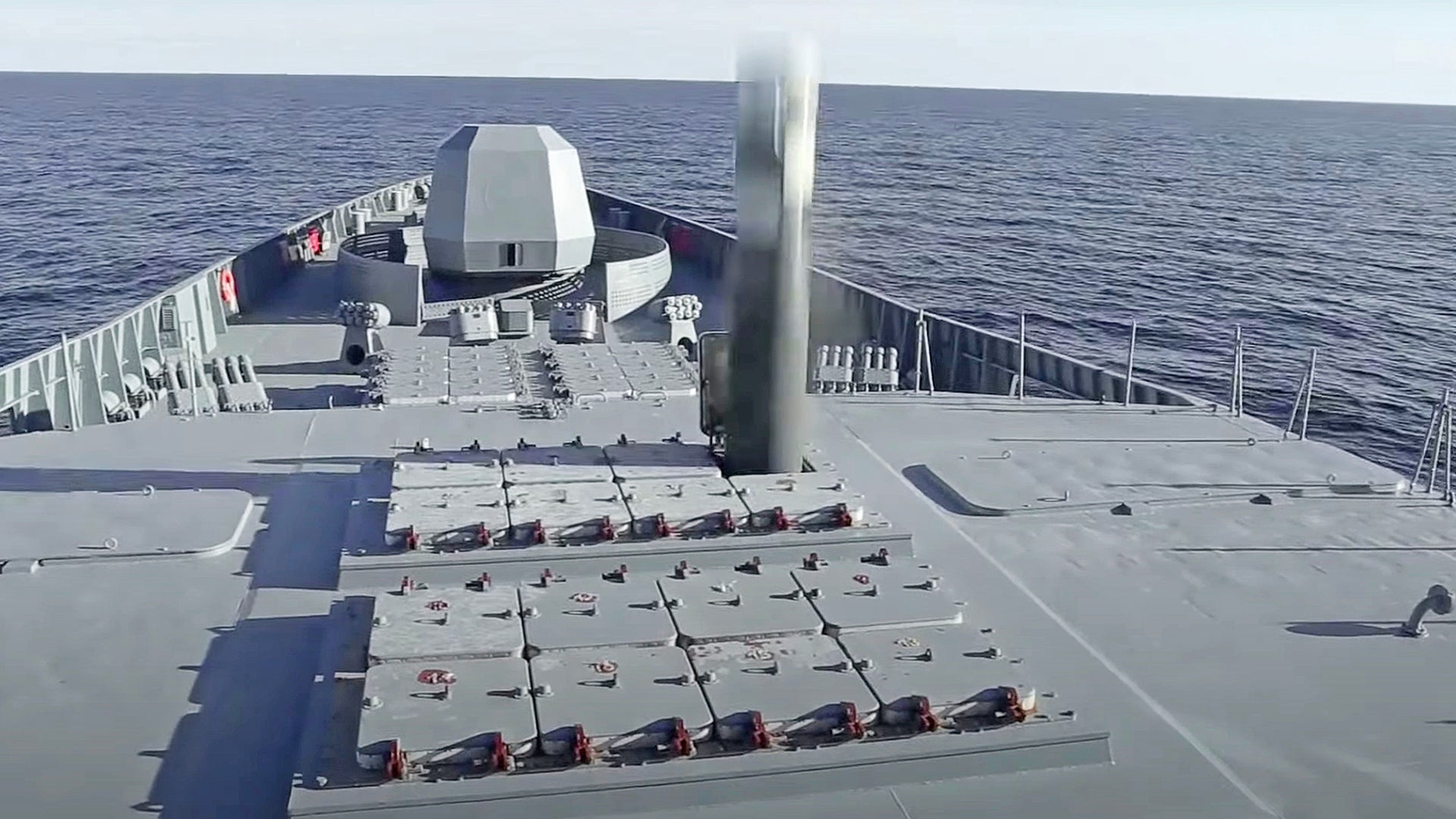
Russia Says This Is Our First Glimpse Of Its Zircon Hypersonic Cruise Missile
Launched from a frigate in the White Sea, the weapon was claimed to have exceeded a speed of Mach 8 before hitting a naval target.
As regards manoeuvring, the missile needs to know when to manoeuvre, which it doesn't, and every manoeuvre causes it to slow down. It might dodge one interceptor, but then there's another. This is why missile attacks tend not to be singular and contain multiple missiles to overload defences. The correct way to deal with it in the general case would be to destroy the launch vehicles and the production facilities producing the launch vehicles and the missiles and any supporting industries.
Salvo attacks with subsonic missiles are also effective though, and cheaper. The main advantage of hypersonic weapons is time sensitive targets more than difficulty of interception, especially when you factor in costs. If you can fire 5-10 subsonic cruise missiles at low altitude, or 10 PrSMs for every one Tsirkon, which causes air defences more problems?
Dilandu
I'm dissatisfied, which means, I exist.
One little - actually, pretty big - problem. Calculation of interception point. The velocity of air-breathing hypersonic missile is not constant. And while it is not very agile, it could still maneuver a bit. And even the slight velocity/course changes could threw your calculated interception point off.Mach 9 is 3km/sec, so detection at 480km means 160 seconds from detection to impact. Detection at 600km means 200 seconds to impact.
Dilandu
I'm dissatisfied, which means, I exist.
Its air-breathing missile. It could regain velocity after each maneuver. And velocity change would actually add problems to interceptor, since it would be forced to recalculate the whole sequence in 3D, having only approximate data about missile velocity.As regards manoeuvring, the missile needs to know when to manoeuvre, which it doesn't, and every manoeuvre causes it to slow down.
DWG
ACCESS: Top Secret
- Joined
- 11 February 2007
- Messages
- 1,754
- Reaction score
- 2,300
Its air-breathing missile. It could regain velocity after each maneuver. And velocity change would actually add problems to interceptor, since it would be forced to recalculate the whole sequence in 3D, having only approximate data about missile velocity.
If we take the first missile on missile intercept as Patriot vs Scud/al Hussayn in 1991, then missile speeds have increased from 1.5km/s to 2.7km/s. Call it doubled.
In the same time processor speed has increased from c10MHz to c5000MHz, so a 500 fold improvement. I'm not convinced recalculation is a major issue.
Dilandu
I'm dissatisfied, which means, I exist.
If we take the first missile on missile intercept as Patriot vs Scud/al Hussayn in 1991, then missile speeds have increased from 1.5km/s to 2.7km/s. Call it doubled.
I'm not talking about merely speed. I'm talking about the ability of air-breathing hypersonic to alter both course and velocity.
Let's assume that Mach 3 SAM is fired against Mach 9 hypersonic missile in such way, that interception point is 50 km from launcher. I.e. the SAM would need about 50 seconds to reach the interception point and make terminal homing.
10 seconds before interception, a Mach 9 hypersonic missile changed its course to 10 degrees in azimuth. The interception point shifted 5.23 km to the side from original position. If the missile also slowed down to Mach 8, it would shift the interception point 6.91 km. And if it also make altitude change...
Essentially the SAM is forced to make 5-10 km course alteration in the last 10 seconds of its flight.
Any maneuvering by the hypersonic would have to be pre arranged as part of the flight plan. If you knew where the defending missiles were based, you could probably complicate the interception significantly, though for targets right next to the launcher, there would be limits to how much the attacking missile could pull off target while still re-engaging.
I think the biggest issue defending against hypersonics it that only a tiny bubble can be defended by expensive, high altitude, low mobility systems. For ships this is probably less of an issue - there are a limited number of targets in a formation and most of them are colocated with a long range SAM system. But land based SAMs have to deal with the fact they do not know what the target will be and that the target set is very diverse across a broad geographical area. There are something like two, maybe three Patriot batteries in Ukraine. The overwhelming majority of the country is probably vulnerable to attacks from high speed missiles.
I think the biggest issue defending against hypersonics it that only a tiny bubble can be defended by expensive, high altitude, low mobility systems. For ships this is probably less of an issue - there are a limited number of targets in a formation and most of them are colocated with a long range SAM system. But land based SAMs have to deal with the fact they do not know what the target will be and that the target set is very diverse across a broad geographical area. There are something like two, maybe three Patriot batteries in Ukraine. The overwhelming majority of the country is probably vulnerable to attacks from high speed missiles.
Last edited:
Forest Green
ACCESS: Above Top Secret
- Joined
- 11 June 2019
- Messages
- 5,124
- Reaction score
- 6,775
At that point it will be rapidly approaching the target area and is limited in its manoeuvres by the need to hit the actual target. Additionally interceptors would be coming thick and fast, with the second one coming as soon as (and if) it dodges the first, so there would be no time to regain speed. Plus, at Mach 10, turns have large radii, speed drops off fast when manoeuvring, and it can't be regained very quickly either. And as the missile enters thicker air while descending on target, it will slow down even more. The ground radar and missile radar will be able to provide accurate velocity and range information at all times, and as I said, there is no pilot, it does not know when to manoeuvre, it can only guess. If it guesses wrong then it will be no more difficult than a BM to intercept.Its air-breathing missile. It could regain velocity after each maneuver. And velocity change would actually add problems to interceptor, since it would be forced to recalculate the whole sequence in 3D, having only approximate data about missile velocity.
Forest Green
ACCESS: Above Top Secret
- Joined
- 11 June 2019
- Messages
- 5,124
- Reaction score
- 6,775
The clock speed belies the real increase in performance. In 1991 processors were 32bit and single core with no hyper-threading.In the same time processor speed has increased from c10MHz to c5000MHz, so a 500 fold improvement. I'm not convinced recalculation is a major issue.
I mean, take a look at this. You're looking a 50 to >300,000 MIPS between 1991 and 2017 (not even 2024), i.e. >6,000. And let's not pretend the Gulf War Patriot system had 1991 chips in it either, more like 1981 given how things work. Chip performance has outpaced missile performance increase by several orders of magnitude.
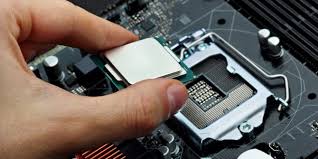
The evolution of the CPU - Aura-Tech Solutions
The Center of Excellence: The staggering pace at which the main component of your favorite gadgets has progressed through the […]
 auratechtt.com
auratechtt.com
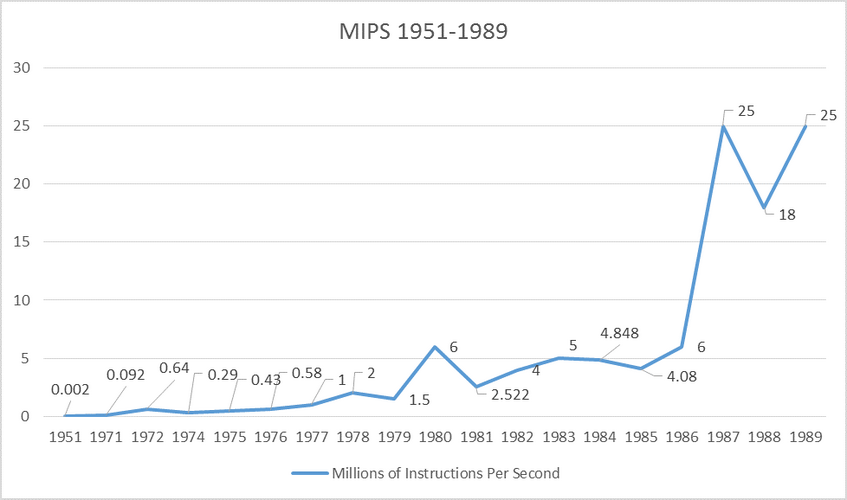
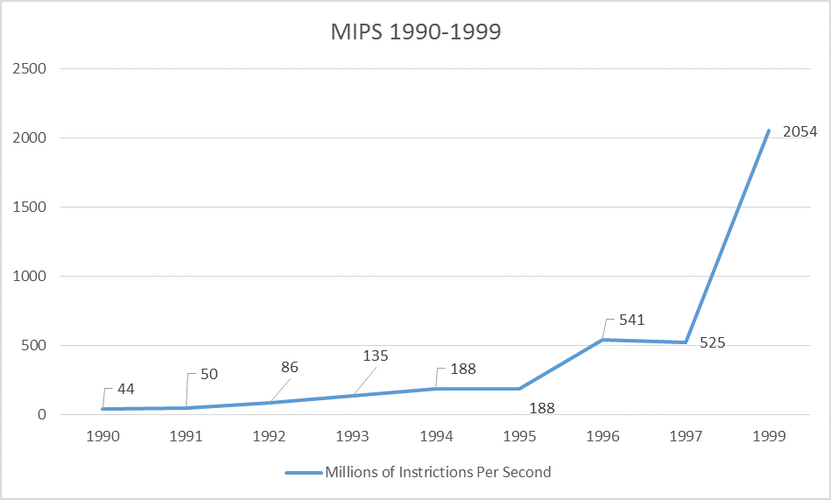
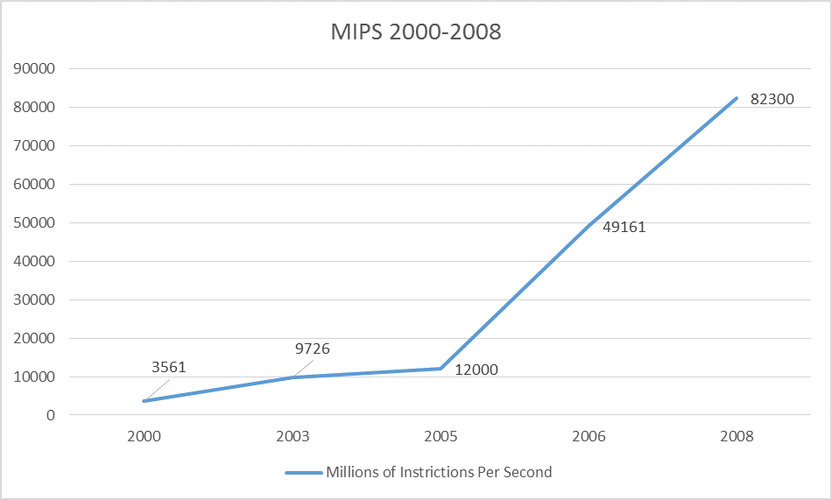
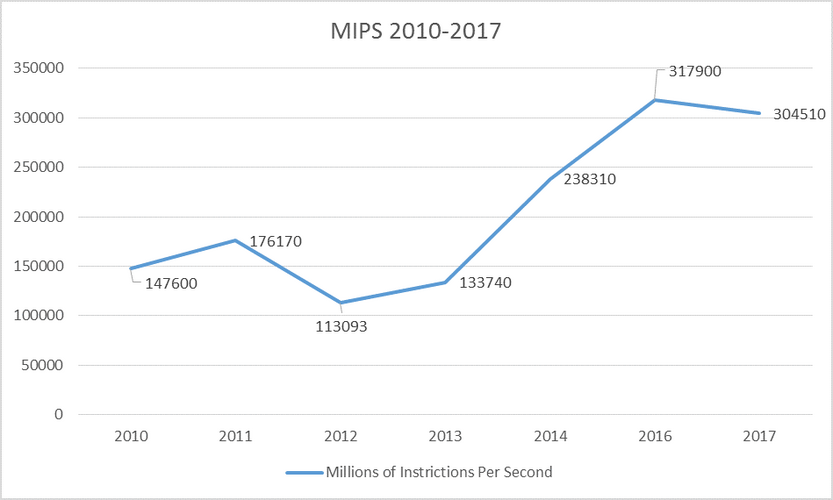
Dilandu
I'm dissatisfied, which means, I exist.
Only if it's already on the terminal run. Before that, it could change course rather efficiently, throwing the launched SAM's off-course.At that point it will be rapidly approaching the target area and is limited in its manoeuvres by the need to hit the actual target.
Which is actually good in terms of throwing off the interception calculations, because reducing the velocity made the missile course even less predictable.Plus, at Mach 10, turns have large radii, speed drops off fast when manoeuvring, and it can't be regained very quickly either.
First of all, it may simply be programmed to make random turns at random points of trajectory. Secondly, nothing forbade missile from actually carrying onboard illumination warning station. We are talking about heavy Russian missiles, after all; our missiles used penetration aids and jammers since 1970s!and as I said, there is no pilot, it does not know when to manoeuvre, it can only guess.
Forest Green
ACCESS: Above Top Secret
- Joined
- 11 June 2019
- Messages
- 5,124
- Reaction score
- 6,775
True enough, IF it manoeuvres at the correct time, but that doesn't really provide any advantage over a traditional BM in the case of Patriot, since Patriot can only perform endospheric intercepts.Only if it's already on the terminal run. Before that, it could change course rather efficiently, throwing the launched SAM's off-course.
Nope. The radar constantly monitors velocity and position, this is ultimately nothing that doesn't happen when intercepting an aircraft, except a good pilot knows when to manoeuvre.Which is actually good in terms of throwing off the interception calculations, because reducing the velocity made the missile course even less predictable.
Random turns may or may not be effective and will reduce range, limiting the quantity thereof.First of all, it may simply be programmed to make random turns at random points of trajectory.
Extra weight and in the terminal phase, which is really the case against PAC-3, the manoeuvres are limited by the need to hit the target. I also suspect decoys would decelerate very fast and thus be fairly ineffective and easily distinguished from the missile. Also, zero reports of decoys on Tsirkons to date.Secondly, nothing forbade missile from actually carrying onboard illumination warning station. We are talking about heavy Russian missiles, after all; our missiles used penetration aids and jammers since 1970s!
And the case of target searching and tracking should be improved with the use of P/AESA radars, especially the widespread use of S-300 series/Patriot/THAAD/HQ-9.
It was also a myth that some thought maneuver meant the attacking missile could react on the intercepting missile, since the days of Sunburn.
It was also a myth that some thought maneuver meant the attacking missile could react on the intercepting missile, since the days of Sunburn.
Last edited:
LMFS
ACCESS: Top Secret
- Joined
- 19 March 2019
- Messages
- 511
- Reaction score
- 760
Those are the US hypersonic weapons? Ok then, no more questions...You mean like Pershing 2?
SM6Blk2 in the surface attack mode is also hypersonic. (that's the 21" rockets, not the 13.5" rockets)
You need to guess or know what is the target of the attacking weapon, to start with, to work out possible interception points that do not deviate massively from the engagement zone of your interceptors, once the missile starts vigorous maneouvering before it hits. And of course 1, 10 or 100 km distance between launchers depends on the relative performance of target and SAM system. Most SAMs are simply surpassed by current hypersonic weapons, no matter under what beneficial circumstances.The difficulty with intercepting hypersonics is how close the interceptor needs to be based to the target in order to get in front of the incoming to make the hit. Like I said, something like 10km away from the target(s) or less. This means you need lots more SAMs to be able to cover all the potential targets.
Still, those exotics were (and are still) developed under the extreme demands placed by some attack systems, I wonder why. As to the first part, we will agree to disagree.We are watching Patriots do this right now, it's not hard to make the intercepts with relatively normal missiles. Not talking exotics like Sprint or HyBEx that pull over 100gees at launch.
It indeed is. "Plasma stealth" is not an on-off type of phenomenon, the density and frequency of the plasma depends on a number of factors as stated above and can therefore be tailored within certain limits.28km is stated as the altitude. That is not high enough for plasma stealth.
Your interpretation is denied by any use of rocket artillery and missile forces basically anywhere in this world in the last 30 years. When you create several km wide, 3D deviation from original interception point with every slight manouver and have an air breathing weapon which is constantly propelled up to the target to hypersonic speed, it is basically a chance in 1 million that you are going to make an interception the way you propose.As regards manoeuvring, the missile needs to know when to manoeuvre, which it doesn't, and every manoeuvre causes it to slow down. It might dodge one interceptor, but then there's another.
Some examples come to mind...The correct way to deal with it in the general case would be to destroy the launch vehicles
I refuse having to explain something so obvious, sorry. I dont know if there is any free online interception calculator, but if you make some numbers you will see how difficult it is in reality. Not to talk about the ability of some of these weapons to be ultimative bunker busters, due to kinematic energy only.Salvo attacks with subsonic missiles are also effective though, and cheaper. The main advantage of hypersonic weapons is time sensitive targets more than difficulty of interception, especially when you factor in costs. If you can fire 5-10 subsonic cruise missiles at low altitude, or 10 PrSMs for every one Tsirkon, which causes air defences more problems?
I am not sure it is not agile, at least in terms of g, they can be subjected to extreme loads. But you are right, the scale of the kinematic challenge placed by such weapons and the speed an interceptor needs to have to have any chance to react to the attacking missile's changes of trajectory are apparently not understood here.One little - actually, pretty big - problem. Calculation of interception point. The velocity of air-breathing hypersonic missile is not constant. And while it is not very agile, it could still maneuver a bit. And even the slight velocity/course changes could threw your calculated interception point off.
Last edited:
Scott Kenny
ACCESS: Above Top Secret
- Joined
- 15 May 2023
- Messages
- 6,016
- Reaction score
- 4,887
It's not the recalculation time, it's the physical time to get the missile to the new intercept point. If it can get there, even.If we take the first missile on missile intercept as Patriot vs Scud/al Hussayn in 1991, then missile speeds have increased from 1.5km/s to 2.7km/s. Call it doubled.
In the same time processor speed has increased from c10MHz to c5000MHz, so a 500 fold improvement. I'm not convinced recalculation is a major issue.
It's part of what makes defending against hypersonics so difficult, and the big part of why you need the defensive missile launchers so close to the targets (which means you need a lot of defensive missile launchers to cover all the possible targets). You do not necessarily need the radar units co-located with the launchers, but the launchers need to be within 10km of the targets to be able to intercept.
Yes. But the flip side is that your hypersonic cannot maneuver easily without taking itself out of the target zone... grrr... there's got to be a better way to say that. I mean that the hypersonics cannot maneuver a whole lot without eliminating some targets as possibilities, simply because the hypersonic cannot maneuver back to hit them.You need to guess or know what is the target of the attacking weapon, to start with, to work out possible interception points that do not deviate massively from the engagement zone of your interceptors, once the missile starts vigorous maneouvering before it hits. And of course 1, 10 or 100 km distance between launchers depends on the relative performance of target and SAM system. Most SAMs are simply surpassed by current hypersonic weapons, no matter under what beneficial circumstances.
And frankly, if you can't determine which of a set of possibilities is the real target, you have all the defensive missile launchers put up a couple of birds. The calculus isn't "those PAC3MSEs are $3mil each and the Tsirkon is only $6mil," it's "the defended factories are $1bn and we can fire over 300 defensive missiles before we spend more defending than the target is worth."
Yes. Sprint and HyBEx were designed to deal with ICBMs, which by nature of the beast are moving somewhere around Mach 20, not too far short of orbital velocity.Still, those exotics were (and are still) developed under the extreme demands placed by some attack systems, I wonder why. As to the first part, we will agree to disagree.
There's a long way between Mach 9 and Mach 20 in terms of required defensive missile kinematics.
DWG
ACCESS: Top Secret
- Joined
- 11 February 2007
- Messages
- 1,754
- Reaction score
- 2,300
Agreed, I was only addressing the recalculation time itself, though the ability to calculate a continuously running intercept solution will help - it's not: oh shit they changed course, just give me 5 seconds to work out where they're going, okay, now we can react.It's not the recalculation time, it's the physical time to get the missile to the new intercept point. If it can get there, even.
the flip side is that your hypersonic cannot maneuver easily without taking itself out of the target zone... grrr... there's got to be a better way to say that.
The actual target constrains the range (set) of possible evasive manouevres. The incoming missile's course is literally funnelled into it.
- Joined
- 3 June 2011
- Messages
- 17,339
- Reaction score
- 9,082
A good analogy is a baseball pitcher throwing a fastball. The catcher doesn't need to move his mitt anywhere near as fast as the ball to catch it.Agreed, I was only addressing the recalculation time itself, though the ability to calculate a continuously running intercept solution will help - it's not: oh shit they changed course, just give me 5 seconds to work out where they're going, okay, now we can react.
The actual target constrains the range (set) of possible evasive manouevres. The incoming missile's course is literally funnelled into it.
Scott Kenny
ACCESS: Above Top Secret
- Joined
- 15 May 2023
- Messages
- 6,016
- Reaction score
- 4,887
So you can eliminate targets based on what maneuvers the hypersonic makes, as it removes that possible target from the funnel.The actual target constrains the range (set) of possible evasive manouevres. The incoming missile's course is literally funnelled into it.
But again, the math is not "Well, a Tsirkon only costs Russia $6mil so it's only worth two PAC3s to intercept." The math is "The factory costs $1bn, so we can shoot over 300 PAC3s before it's costing more to defend the factory than it'd cost to replace the factory."
LMFS
ACCESS: Top Secret
- Joined
- 19 March 2019
- Messages
- 511
- Reaction score
- 760
I am not able to find it now, but I have seen some very fancy attack trajectories by hypersonic warheads, literally looping around the target before impacting. But I understand what you mean and obviously point defence is the optimum situation for the AD. That does not mean that you can hit a manoeuvring hypersonic weapon just by lobbing interceptors at it, as some appear to assume.Yes. But the flip side is that your hypersonic cannot maneuver easily without taking itself out of the target zone... grrr... there's got to be a better way to say that. I mean that the hypersonics cannot maneuver a whole lot without eliminating some targets as possibilities, simply because the hypersonic cannot maneuver back to hit them.
- Joined
- 3 June 2011
- Messages
- 17,339
- Reaction score
- 9,082
"Looping around the target" might be a bit of an exaggeration. Missiles going that fast don't "loop". This is what a maneuvering RV looks like trying to evade a PAC-3:I am not able to find it now, but I have seen some very fancy attack trajectories by hypersonic warheads, literally looping around the target before impacting. But I understand what you mean and obviously point defence is the optimum situation for the AD. That does not mean that you can hit a manoeuvring hypersonic weapon just by lobbing interceptors at it, as some appear to assume.
The targets turn radius is so large it looks like it's going straight when you see it in frame. The only way you can tell it's maneuvering is by watching what the PAC-3 is having to do to get in position.
Similar threads
-
-
-
-
9M730 Burevestnik (SSC-X-9 Skyfall) cruise nuclear-powered missile
- Started by Brickmuppet
- Replies: 264
-
U.S. military to test missiles banned under faltering nuclear pact with Russia
- Started by seruriermarshal
- Replies: 17

